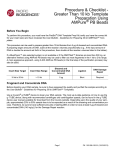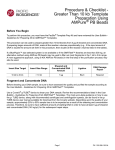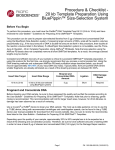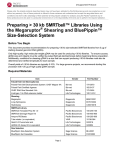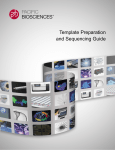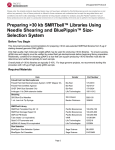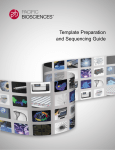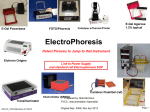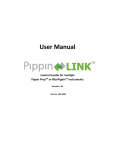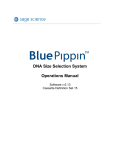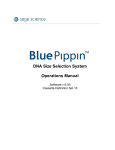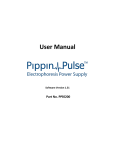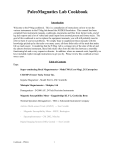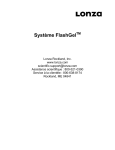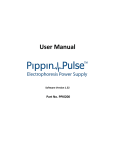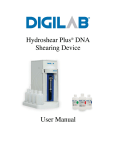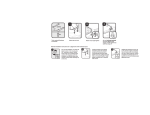Download User Bulletin - Guidelines for Preparing 20 kb SMRTbell™ Templates
Transcript
Guidelines for Preparing 20 kb SMRTbell™ Templates User Bulletin This Bulletin provides recommendations and tips for preparing 20 kb SMRTbell templates using the BluePippin™ size-selection method. Once you have read this User Bulletin, proceed to the Procedure & Checklist - 20 kb Template Preparation and Sequencing for preparing your 20 kb SMRTbell templates. Before You Begin Materials and Kits needed: To perform this procedure you must have the following kits, materials, and instrumentation: Item Vendor DNA Template Prep Kit 2.0 (3 kb to 10 kb) Pacific Biosciences DNA/Polymerase Binding Kit (polymerase of choice) Pacific Biosciences DNA Sequencing Kit or DNA Sequencing Kit XL Pacific Biosciences MagBead Binding Kit Pacific Biosciences SMRT® Cell 8Pac v3 Pacific Biosciences BluePippin™ system with Software v5.90 or later (see www.sagescience.com for ordering information and links to downloadable software and installation instructions) The BluePippin User Manual may be found at: http://www.sagescience.com/support/ Sage Science (PN BLU0001) PacBio® SMRTbell cassette definition set (see http://www.sagescience.com/support/ for downloadable file and installation instructions) Sage Science 0.75% Dye-Free Agarose Gel Cassettes, 1 -10 kb (to order, go to: Sage Science (PN BLF7510) http://www.sagescience.com/products/cassettes/0-75-agarose/ The Quick Guide for this cassette at: http://www.sagescience.com/wp- content/ uploads/2011/10/Quick-Guide-BLF7510-marker-S1.pdf NanoDrop® Spectrophotometer (Series 2000, 2000c, 3300, or 8000) Qubit® Fluorometer and Quant-iT™ HS dsDNA reagent g-TUBE® microcentrifuge tubes AMPure® PB Beads Thermo Scientific Invitrogen (PN Q32857 or Q32851) Covaris Pacific Biosciences Handling High-Molecular-Weight DNA Proper care of gDNA must be taken to minimize damage. • • • • Do not vortex gDNA prior to shearing Avoid excessive pipetting Avoid multiple freeze/thaw cycles Avoid excessive heat Assess the Quality of Starting DNA Pure (free from RNA or other organic and inorganic contaminants), high-molecular-weight DNA is required to prepare size-selected ~20 kb SMRTbell templates. Measure the gDNA concentration using both a NanoDrop spectrophotometer and a Qubit fluorometer. If any of the following is true, use 0.45X AMPure PB beads to concentrate and/or purify the DNA before shearing, following the steps below. 1. The gDNA concentration is less than 200 ng/µL. 2. The OD 260/280 is less than 1.8 or greater than 2.0. If the gDNA concentration determined by the Qubit fluorometer is significantly less than the concentration determined by the NanoDrop spectrophotometer, this may indicate RNA contamination. Performing 0.45X AMPure PB purification removes most RNA contaminations. To assess the integrity of gDNA, we recommend running both an agarose gel electrophoresis such as 1.2% Lonza™ FlashGel™ with FlashGel DNA marker 100 bp - 4 kb and a Field-Inversion Gel Electrophoresis (FIGE) system such as the CHEF Mapper® XA System (Bio-Rad; P/N 170-3760) or Pippin Pulse power supply (Sage Science; P/N PP10200). Agarose gel electrophoresis allows you to quickly view degraded DNA. Depending on the goals of your project, you may not want to proceed with library construction if the DNA sample is degraded. Use a standard, low-percent gel with a DNA ladder that goes to >10 kb. Genomic DNA samples should run above the largest band in the ladder. One such system is E-Gel® 0.8% gels. At a minimum, 1.2% Lonza™ FlashGel™ gels with FlashGel™ DNA marker 100 bp – 4 kb can be used to rule out highly degraded samples. See figure 1 below. Note that small fragments often inflate quantitation. Check the Lonza gel for small fragments 1 minute after starting the run to check for small fragments. Figure 1: Quality assessment of two samples run on agarose gel electrophoresis (1.2% Lonza Gel) • Lane 1: FlashGel™ DNA marker 100 bp – 4 kb • Lane 2: Degraded gDNA • Lane 3: Intact gDNA • Lane 4: FlashGel™ DNA marker 100 bp – 4 kb PN 100-286-700-01 (10/07/2013) Consider using an FIGE system to evaluate the quality of gDNA and determine the sizes of sheared DNA and SMRTbell templates (see figure 2 below). On a field-inversion gel, high-quality gDNA should migrate as a single band of approximately 50 kb (Lane 2). Run approximately 200 ng of gDNA on a field-inversion gel. 1 2 3 4 5 Figure 2. FIGE was performed using a CHEF Mapper (Bio-Rad) according to the manufacturer’s recommendations, with a low-range target of 1 kb and a high range target of 50 kb. 100-200 ng of each sample was loaded per lane. • • • • • Lane 1: 2.5 kb Molecular Ruler (Bio-Rad; P/N 170-8205) Lane 2: starting gDNA sample Lane 3: 20 kb sheared DNA Lane 4: 20 kb SMRTbell template before size selection Lane 5; BluePippin size-selected 20 kb SMRTbell template PN 100-286-700-01 (10/07/2013) Because constant voltage gel electrophoresis does not resolve high-molecular-weight fragments, what appears to be high-molecular-weight DNA may not be accurate. Figure 3 below shows the same samples run on both constant voltage electrophoresis and field inversion gel electrophoresis (FIGE). 1 2 3 4 5 6 7 8 9 4 kb 1 2 3 4 5 6 7 8 9 4 kb 10 kb Figure 3a: Samples run on 1.2% Lonza Gel. Lanes 3-8 appear to be high molecular weight on agarose gel. Figure 3b: The same samples run on FIGE using a Pippin Pulse Power Supply show sample degradation. Lane 1: Lane 2: Lane 3: Lane 4: Lane 5: Lane 6: Lane 7: Lane 8: Lane 9: Lane 1: Lane 2: Lane 3: Lane 4: Lane 5: Lane 6: Lane 7: Lane 8: Lane 9: FlashGel™ DNA marker 100 bp – 4 kb Sample 1 Sample 2 Sample 3 Sample 4 Sample 5 Sample 6 Sample 7 FlashGel™ DNA marker 100 bp – 4 kb 8 kb - 48 kb DNA Size Standard from Bio-Rad 2.5 kb Molecular Ruler from Bio-Rad Sample 1 Sample 2 Sample 3 Sample 4 Sample 5 Sample 6 Sample 7 If the majority of the sample is < 10 kb, and there is no higher-quality sample available, you may want to prepare a library from the unsheared sample (following the standard 10 kb SMRTbell library protocol). However, this may result in shorter subread lengths. If the goal of the project is to generate the longest reads possible using the PacBio P5/C3 chemistry and180 min movies, consider preparing higher quality gDNA. Figure 4 below shows a comparison of subread lengths from degraded and high quality gDNA. Figure 4a: Subread-length Distribution from a degraded genomic DNA. Figure 4b: Subread-length Distribution from high-quality genomic DNA PN 100-286-700-01 (10/07/2013) Once you have assessed the quality of your gDNA, you can proceed by following the workflow below. QC Shearing Library Construction Library Size Selection PN 100-286-700-01 (10/07/2013) Shear and Purify DNA Note that prior to shearing, gentle mixing is recommended. This recommendation will hold for larger insert sizes, however, for 20 kb libraries no damage has been observed as a result of vortexing. Also, typical yields after shearing and AMPure purification are 50-70%, depending on the quality and purity of the input gDNA. We recommend starting with at least 7.5 μg to 10 μg input gDNA in order to produce 5 μg sheared and concentrated DNA for subsequent steps. Use a Covaris® g-TUBE® device to shear > 5 μg DNA sample. The most up-to-date guidance on how to use the g-TUBE device, along with recommended centrifuges and centrifugation speeds, can be found in the g-TUBE device user manual available for download from the Covaris website or the Shared Protocols page of SampleNet, with the following changes: 1. Dilute your DNA concentration to 200-300 ng/μL in Elution Buffer (EB). The sample volume may range from 25-100 μL. 2. Shear at 5500 rpm for 1 minute in an Eppendorf® MiniSpin plus. 3. Check for any residual sample remaining in the upper chamber. If present, add 30 μL of EB, flick the tube, and spin again at 5500 rpm for another minute in the same orientation. If not, proceed to step 5. 4. Again, check for residual sample. If present, add another 30 μL EB and spin at 6000 rpm. Repeat until you no longer see anything in the upper chamber. 5. Invert and re-spin. 6. Recover your sample into a 1.5 or 2.0 mL LoBind microcentrifuge tube. Add EB if necessary to adjust volume to at least 100 μL. BluePippin™ Size Selection With BluePippin size selection, the lower and upper limits of the selected range can be adjusted. We recommend keeping the upper size limit (BP end) at 50000 (50 kb). The lower size limit (BP start) may be varied, depending on several factors: • • • • Size distribution in the library Amount of SMRTbell DNA in the library Target size for sequencing reads for the project Number of Mbases required for the project For size selection of an optimized large-insert library, we recommend a BP start of 7000 bp. If most of the fragments in the library are > 15kb, and you plan to size select >4 μg of template, you may consider increasing the BP start to 10000 bp. For shorter inserts, use a size cut-off well below the size of most of the fragments to obtain the typical yield. For example, if the peak of the library size distribution is around 10 kb - 12kb, you may consider a BP start of 4000. If a more stringent size selection is desired, the yield is likely to be considerably lower. Important Note: When loading 2 μg or less per well, subtract 3000 from the desired BP start, as lower amounts tend to run faster on the BluePippin system. If the library contains < 0.5 μg, or if there is a broad size distribution to < 4 kb, then a 0.40X AMPure purification step is recommended instead of the BluePippin size selection system to avoid losing the library. PN 100-286-700-01 (10/07/2013) Alternative Removal of Short Fragments with 0.40X AMPure® PB Beads If the library is < 0.5 μg, or if there is a broad size distribution of < 4 kb, recovery from gel sizing will likely be very low, and a lower X AMPure PB bead purification may be preferred. This will remove or minimize fragments in the 1 – 2 kb range. Note that it is critical to accurately pipet the desired volume of AMPure PB bead solution; there is a steep dropoff in recovery for concentrations < 0.40X. To facilitate accurate pipetting, carry out 0.40X AMPure PB bead purification separations with a minimum 100 μL sample and 40 μL AMPure PB beads; dilute sample in EB, if necessary. Follow the protocol on page 12 (except for the volume of AMPure PB beads in Step 1). Recovery is typically 60-90% from 0.40X AMPure PB Beads. If a higher stringency size selection is desired, AMPure PB concentration may be reduced to as low as 0.35X. For < 0.40X AMPure purifications, recovery is often in the range of 5-25%. For < 0.40X AMPure purifications, be sure to save the supernatant from the binding step until after you have verified the eluted library. If the final yield is too low, add 0.6X AMPure PB beads to the saved supernatant and re-bind to recover lost the sample. Continue from above. Anneal and Bind BluePippin™ Size-Selected SMRTbell™ Templates Use the Binding Calculator in RS Remote to anneal sequencing primer at 0.8333 nM template and bind polymerase at 0.5 nM template to size-selected SMRTbell templates. Enter 20,000 bases as the average insert size and select Magnetic Beads, small scale reaction, and no DNA control template. For more information about using the Binding Calculator, see the Pacific Biosciences Template Preparation and Sequencing Guide. On-plate Loading Recommendations There are differences in loading requirements between the BluePippin size-selected libraries and AMPure selected libraries. BluePippin size-selected libraries require higher loading concentrations with approximately 25 pM on the SMRT Cell (125 pM on Plate). However, if your library is size-selected using AMPure PB beads, a 25 pM on SMRT Cell loading will result in overloading. Long insert libraries, size selected with 0.40X (or 0.375X) AMPure PB beads, will still contain shorter SMRTbells, therefore, the required loading concentration is lower, approximately 5 - 10 pM on SMRT Cell (25 - 50 pM on plate). Prior to loading these samples on the PacBio RS system, please perform titration runs to maximize the yield per SMRT Cell. For Research Use Only. Not for use in diagnostic procedures. © Copyright 2013, Pacific Biosciences of California, Inc. All rights reserved. Information in this document is subject to change without notice. Pacific Biosciences assumes no responsibility for any errors or omissions in this document. Certain notices, terms, conditions and/or use restrictions may pertain to your use of Pacific Biosciences products and/or third party products. Please refer to the applicable Pacific Biosciences Terms and Conditions of Sale and to the applicable license terms at http://www.pacificbiosciences.com/licenses.html. Pacific Biosciences, the Pacific Biosciences logo, PacBio, SMRT and SMRTbell are trademarks of Pacific Biosciences in the United States and/or certain other countries. All other trademarks are the sole property of their respective owners. PN 100-286-700-01 (10/07/2013)








